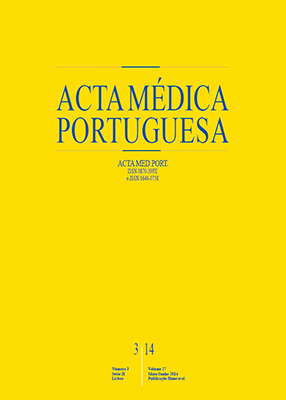Meningococcal Disease Admissions in a Paediatric Intensive Care Unit
DOI:
https://doi.org/10.20344/amp.4073Abstract
Introduction: Meningococcal infection has a high mortality and morbidity in children. Aggressive initial shock approach, early referral, secondary transport and vaccination are potential factors with impact in reducing its mortality. Objectives were to characterize children admitted to intensive care due to invasive meningococcal disease, to evaluate their prognostic scores and mortality.Material and Methods: Observational study, with retrospective data collection. Two periods were created according to the year of admission (A: 2000-2005 and B: 2006-2011). Prognostic parameters, organ failure and mortality rates were compared in these groups.
Results: 70 children were admitted with invasive meningococcal disease. When compared with other causes of admission, a decrease in the number of admissions due to invasive meningococcal disease was observed (period A: 3.4%; period B: 1.5%; p = 0.001). The presence of meningitis was 41% in period A and 29% in period B (p = 0.461). Rapidly progressive purpura occurred in 78% in period A and 50% in period B (p = 0.032). Children from period A had multi-organ failure (80%), disseminated intravascular coagulation (76%) and coma (22%) more frequently than children from period B (29%, 29%, 0%; p < 0.05). Mortality was 26% in period A and 0% in period B (p = 0.006) and standardized mortality by PRISM was 1.3 and 0 in period A and B respectively.
Discussion: The decrease in the number of admissions due to invasive meningococcal disease can be explained by the introduction of anti-meningococcal C vaccine in 2006. Mortality decline can be possibly explained by an improvement in the initial patient stabilization and to secondary transport.
Conclusion: A decrease in the number of admissions due to invasive meningococcal disease and in mortality was observed.
Keywords: Child; Infant; Intensive Care Units, Pediatric; Meningococcal Infections; Multiple Organ Failure; Mortality; Portugal; Sepsis.
Downloads
Downloads
Published
How to Cite
Issue
Section
License
All the articles published in the AMP are open access and comply with the requirements of funding agencies or academic institutions. The AMP is governed by the terms of the Creative Commons ‘Attribution – Non-Commercial Use - (CC-BY-NC)’ license, regarding the use by third parties.
It is the author’s responsibility to obtain approval for the reproduction of figures, tables, etc. from other publications.
Upon acceptance of an article for publication, the authors will be asked to complete the ICMJE “Copyright Liability and Copyright Sharing Statement “(http://www.actamedicaportuguesa.com/info/AMP-NormasPublicacao.pdf) and the “Declaration of Potential Conflicts of Interest” (http:// www.icmje.org/conflicts-of-interest). An e-mail will be sent to the corresponding author to acknowledge receipt of the manuscript.
After publication, the authors are authorised to make their articles available in repositories of their institutions of origin, as long as they always mention where they were published and according to the Creative Commons license.









